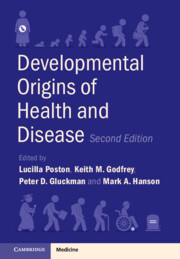Book contents
- Developmental Origins of Health and Disease
- Developmental Origins of Health and Disease
- Copyright page
- Contents
- Contributors
- Preface
- Section I Overview
- Section II Exposures Driving Long-Term DOHaD Effects
- Chapter 2 The Evolutionary Basis of DOHaD
- Chapter 3 Timing
- Chapter 4 Long-Term Effects of Food Insecurity and Undernutrition in Early Life
- Chapter 5 Short- and Long-Term Effects of Maternal Obesity and Dysglycaemia for Women and Their Children
- Chapter 6 Long-Term Effects of Prenatal Maternal Stress and Mental Health
- Chapter 7 Environmental Exposures in Early Life
- Chapter 8 Developmental Programming and the Microbiome
- Chapter 9 Exposures Driving Long-Term DOHaD Effects
- Section III Outcomes
- Section IV Mechanisms
- Section V Interventions
- Section VI Public Health and Policy Implications of Interventions
- Index
- References
Chapter 2 - The Evolutionary Basis of DOHaD
from Section II - Exposures Driving Long-Term DOHaD Effects
Published online by Cambridge University Press: 01 December 2022
- Developmental Origins of Health and Disease
- Developmental Origins of Health and Disease
- Copyright page
- Contents
- Contributors
- Preface
- Section I Overview
- Section II Exposures Driving Long-Term DOHaD Effects
- Chapter 2 The Evolutionary Basis of DOHaD
- Chapter 3 Timing
- Chapter 4 Long-Term Effects of Food Insecurity and Undernutrition in Early Life
- Chapter 5 Short- and Long-Term Effects of Maternal Obesity and Dysglycaemia for Women and Their Children
- Chapter 6 Long-Term Effects of Prenatal Maternal Stress and Mental Health
- Chapter 7 Environmental Exposures in Early Life
- Chapter 8 Developmental Programming and the Microbiome
- Chapter 9 Exposures Driving Long-Term DOHaD Effects
- Section III Outcomes
- Section IV Mechanisms
- Section V Interventions
- Section VI Public Health and Policy Implications of Interventions
- Index
- References
Summary
Two of the pathways by which evolutionary processes can influence disease risk are evolutionary mismatch, where the individual’s evolved coping mechanisms are overwhelmed by a novel or severe cue, and developmental mismatch, where the individual is exposed to an environment that is not matched to its adaptively developed phenotype. Both pathways draw on the evolutionary principle that selection operates to sustain and promote Darwinian fitness, irrespective of the impact on health during the post-reproductive age. In this chapter we will frame DOHaD phenomena within an evolutionary context, showing that human health and disease risk are dependent on our both evolutionary and developmental histories. We also discuss the contributory role of a unique human activity to not only construct a niche but also continually modify it. Using nutrition as the exemplar, we demonstrate how the DOHaD phenomenon is underpinned by both evolutionary and developmental mismatches, and discuss the evidence for how developmental anticipatory responses may confer adaptive advantage in humans.
- Type
- Chapter
- Information
- Developmental Origins of Health and Disease , pp. 7 - 15Publisher: Cambridge University PressPrint publication year: 2022

